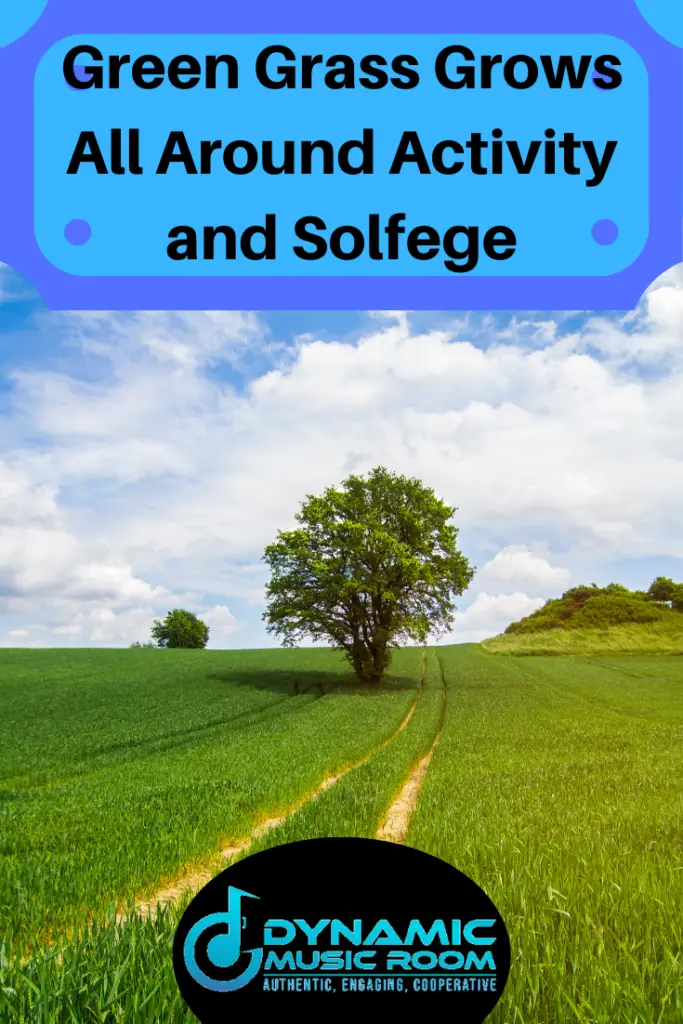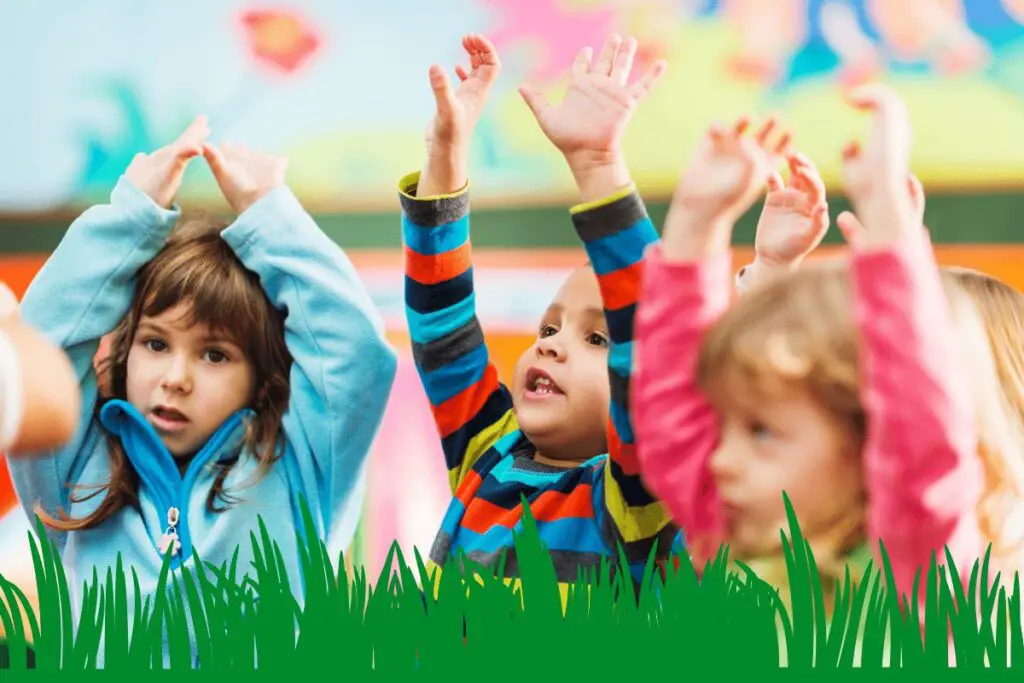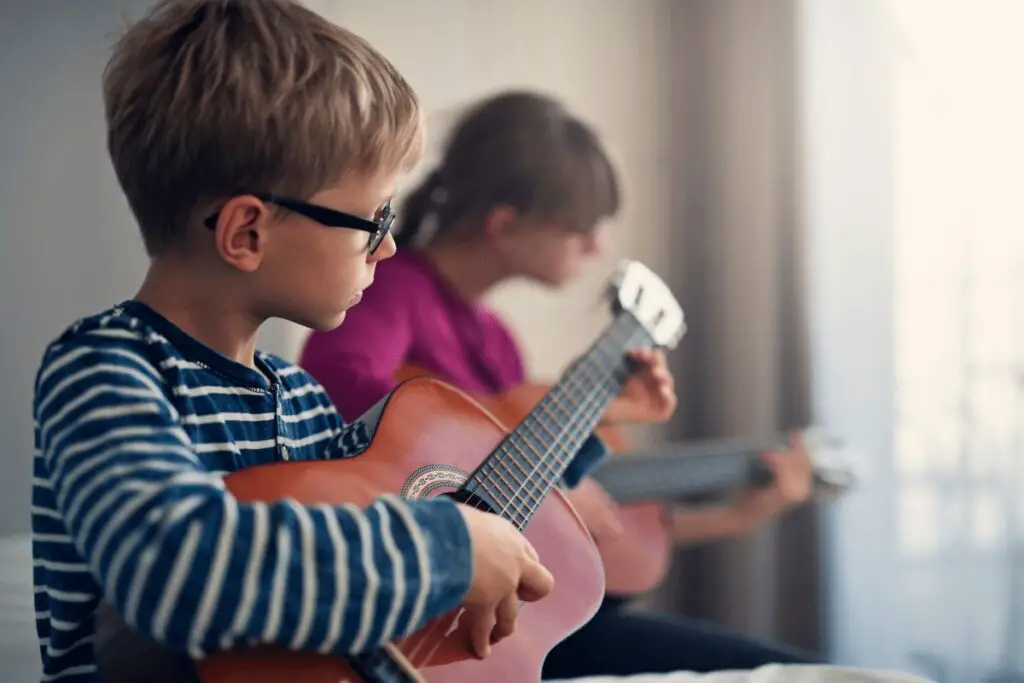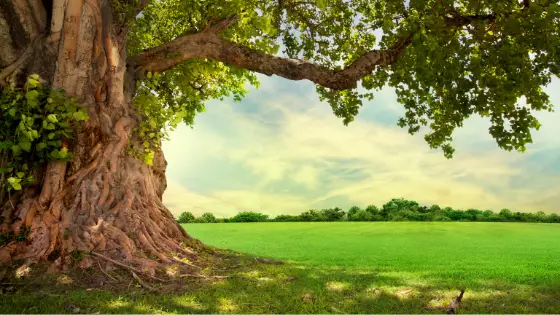Are you looking for some activities to play with the song, Green Grass Grew All Around?
Do you want to check out some sample lessons with the song?
As far as fun and silly songs with additive form go, this one of the best ones. But it may be hard to imagine what to do with the tune.
I checked around and got creative to come up with this Green Grass Grows All Around activity.
The Green Grass Grew All Around song is a blast to sing with kids. It’s made up of both an echo and a simple song. The activity involves doing the motions for each of the additive verses and a quick right arm swing during the simple song.
Read ahead for more information on the song including a breakdown of the song, activity for playing, sample lesson idea, and chords for playing.

Save time with these 60 FREE Music Resources to use in your room right away!
Stop searching the whole internet to find good activities. I’ll help you cut to the chase with my favorite 60 FREE resources.
Table of Contents
Green Grass Grew All Around Song Breakdown
This song is fun to do with younger students such as first and second grade.
Kindergarten may be able to do it as well, but they tend to get overwhelmed as the song goes on.
Lyrics:
Many variations exist in the verses. Here is my personal favorite one.
Echo Section V1
Oh, in the woods…
There was a tree…
The prettiest tree…
That you ever did see…
Additive Section
The tree was in the hole and the hole was in the ground and the green grass grew all around and around and the green grass grew all around.
Echo Section V2
And on that tree…
There was a limb…
The prettiest limb…
That you ever did see…
Additive Section
And the branch was on the tree and the tree was in the hole and the hole was in the ground and the green grass grew all around and around and the green grass grew all around.
Note: From here the song keeps adding. To save time, I’ll just write the new part by verse.
- There was a limb…
- There was a twig…
- There was a nest…
- There was a bird…
- There was a wing…
- There was a feather…
- There was a bug…
- There was a germ…
- There was a sign that said, “The End!”
Pitches: low sol, do, re, mi, fa, sol, la
Rhythms: Paired eighth notes, quarter rest, quarter note
Chords: I, IV, V(7)
Form: Echo song, cumulative song, simple song
Basically, the song starts with an echo portion.
Then, it turns into a cumulative portion by adding the verses sung together.
At the tail end of this additive portion is a simple portion.
Origin: The song was first written in 1877 in Nursery Rhymes and Country Songs by Miss M. H. Mason. This means the folk song is probably older than this.
Certainly the song is in the Appalachian folk style and may be related to the Irish tune, Rattlin’ Bog.
This song is seen under three titles:
- The Green Grass Grew All Around
- And The Green Grass Grows All Around
- And The Green Grass Grew All Around
How To Teach Green Grass Grew

Save time with these 60 FREE Music Resources to use in your room right away!
Stop searching the whole internet to find good activities. I’ll help you cut to the chase with my favorite 60 FREE resources.
This song is a little complicated, but the kids will learn it just through repetition.
If you want to check out my teaching process, here’s what I do to make it a little easier.
- Ask students to echo sing and move the first section.
- Out in the woods, there was a tree, the prettiest tree, that you ever did see
- Ask students to watch you do the cumulative section.
- The tree was in the hole and the hole was in the ground and the green grass grew all around and around and the green grass grew all around.
- Point out how you did the moves backwards (see below) and ended with the green grass part.
- Echo sing the second verse
- And on that tree, there was a limb, the prettiest…
- Ask students to do the moves while you sing the cumulative part.
- Echo sings the third verse.
- Ask students to do the move while you sing the cumulative part. Encourage them to sing as well on the “and the green grass grew…” part.
- Repeat steps 6 and 7 with verses four and five.
- Repeat steps with verses six and seven, but tell them you’re not going to sing the final line anymore. It’s all up to them.
- Repeat with the rest of the song.
- In future classes, encourage them to sing the cumulative section as well.
I like this sequence because it removes much of the hardest part of the song while still giving them experience in how this part of the song is supposed to go.
It still keeps the students engaged with movement and scales up to where they’re comfortable.
When they’re ready, add the full movements below.

Green Grass Grows All Around Activity
For the game or activity, students should be standing in a circle or scattered around the room with a partner.
During the echo/verse portion of the song, the teacher leads and does motions matching the lyrics as I’ll describe below.
The additive portion does the same moves in reverse.
When the class gets to the simple song, “…and the green grass grows all around…”, the partners do a right arm swing and return to their spots.
Here are the moves:
- And in the woods = hands up at eyebrow looking in the distance*
- There was a tree = Hands down at sides**
- The prettiest tree = Wiggle the last move
- That you ever did see = Hold up hands like binoculars
- The tree was in the hole = Make a circle with arms
- And the hole was in the ground = Point at the ground
- And the green grass grew all…. = Right arm swing
*The first move of the echo cycle is the same move as the last verse.
**This one changes depending on the verse (as I’ll show below).
The rest work their way backwards from where you are.
The last two stay the same.
Here are the rest of the verses’ special moves:
- There was a limb = One arm straight out
- There was a branch = Arm bent up at the elbow
- There was a twig = Index finger pointed out
- There was a nest = hands cupped together in a nest shape
- There was a bird = flapping arms like wings
- There was a wing = one arm bent in like a wing
- There was a feather = index finger pointed out while arm is in like a wing
- There was a bug = hands together with small creepy fingers
- There was a germ = two fingers together miming something small
- He had a sign = pretend to hold up a sign
Coupled with the right arm swing at the end of each verse, the kids love to play this one.
Often, I’ll also speed up the additive section as it gets longer and longer. This is a great segue for teaching or reviewing tempo as well!
Lesson Plan

Grade: First/Second
Concept: Composing new lyrics
Behavioral Objectives:
- Students will be able to follow the sequence of the lyrics by creating new lyrics as a class.
- Students will be able to perform the form of the song with new lyrics.
Materials Needed: Place to write and brainstorm lyrics
Assessment:
During the process, the teacher will assess how well each student understands how the lyrics fit in the sequence and form of the song by asking for hand gestures to indicate feedback from the students.
For example: if the class decided to create a new version of the song based on a skyscraper, you may suggest one of the verses be about a truck.
With this suggestion, ask the students if it fits with the sequence and rhyming of the song.
Procedure:
- Sing the song and play the activity from above.
- Send students back to where they normally sit.
- Introduce the idea of creating new lyrics.
- I love this song so much, but after a while, I want something new. I’m going to make some new lyrics.
- Model the creative process.
- So the other day I wanted to make new lyrics to this song, and I noticed this song is really about one thing.
- Do you know what that is? (A tree, and the parts of a tree).
- I’m going to take a single thing with many parts and use this as the base for my new song. Let’s use a house (or another idea you prefer).
- Now, I’m going to list the parts of a house from biggest to smallest. I could go on forever, but I’m going to stick with 5.
- Now I have my first draft. (Brainstorm 5 ideas but make sure one doesn’t fit).
- Model the reflective process.
- All right. I’m almost done, but I need to check my work and see if I can improve it.
- Sing a little of the echo part only testing each object.
- Hm…if you think all is well, give me a thumbs up. If you think there’s some room for improvement somewhere or something that doesn’t match, give me a thumbs down.
- OK. I agree, something doesn’t fit. Which one doesn’t fit? What else can we use in its place?
- Test again.
- Turn the lesson over to the class. Facilitate the composition* either as a whole class with voting or small groups of 3 or 4.
- During the process, the teacher assesses by either asking for visual feedback or listening in to small group discussions.
- Each group or whole class performs the new version of the song.
*You may find it helpful to list or suggest prompts for the new theme of the song. Here are some of my favorites:
- Truck
- Car
- Football gear
- School
- Mountain
- A cake
- Building
- Skyscraper
- City
Social Studies Connection
Using a similar lyric-replacement sequence, there’s a great opportunity to provide a social studies connection much-needed in American schools.
Instead of singing based on the parts of a tree as it gets smaller, you could sing about the divisions of government.
Sounds thrilling, right?
I’m not talking about branches of government either (although this would fit too!).
I mean the sequence of divisions second-graders should know but always seem to struggle to understand.
Country ⇾ State ⇾ County ⇾ City ⇾ Town
This works better if you come up with your own lyrics or, even better, if you create it as a class. Never forget to include motions to engage more learners either.
I won’t use this version often, but I’ll bring it in 1-3 different lessons just as a different twist to the normal version.
If I have the ability to plan ahead for an observation, this variation also makes a great part of any lesson observed by an administrator. *wink wink*.
Guitar And Ukulele Chords

When sung in the key of G major, the chords for this folk song are easy to play on ukulele or guitar.
The song uses I, IV, and V (or V7).
Check out where the chords change with the notation above.
Here are the notes for the chords:
- G Major
- G, B, D
- C Major
- C, E, G
- D Major (or D7)
- D, F#, A (C)
Guitar Chord Fingerings
- G Major
- Middle finger, second string, second fret
- Ring finger, first string, third fret
- Little finger, sixth string, third fret
- C Major
- Index finger, fifth string, first fret
- Middle finger, third string, second fret
- Ring finger, second string, third fret
- D Major
- Index finger, fourth string, second fret
- Middle finger, sixth string, second fret
- Ring finger, fifth string, third fret
- D7
- Index finger, fifth string, first fret
- Middle finger, fourth string, second fret
- Ring finger, sixth string, second fret
Ukulele Chord Fingerings
- G Major
- Index finger, second string, second fret
- Middle finger, fourth string, second fret
- Ring finger, third string, third fret
- C Major
- Ring finger, fourth string, third fret
- D Major
- Flatten middle finger over strings 1, 2, and 3 on the second fret
- D7
- Index finger, first string, second fret
- Middle finger, third string, second fret
Conclusion
I hope you find this Green Grass Grows All Around activity helpful for your music classroom.
I’ve loved teaching this one over the years.
My younger students love trying to create a new version of the song as the lesson describes, and I’ve even taught this simple tune to beginning ukulele and guitar players.

